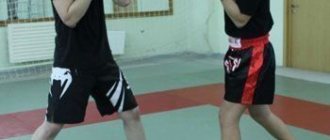To develop strength for a boxing punch, you need to choose the right exercises and perform them correctly.
It is necessary to use movements in training that imitate real punches in boxing, pushing movements.
The exercises below will help you develop explosive power, but you need to do them regularly with proper technique.
The following set of exercises to increase punching power should be done twice a week. The complex targets all major muscle groups that are involved in the strike.
Remember that before performing exercises you should always do a warm-up to warm up your muscles.
Depth jumps with dumbbells
It is preferable that depth jumps be performed without weight due to the stress on the joints. But I would suggest you try doing this exercise with a 5 kg dumbbell. If you follow the execution technique, nothing bad will happen.
The depth jump is a basic plyometrics exercise.
A depth jump is a jump down from a certain height (usually 50-70 cm) with an immediate jump up. It is extremely important that landing and jumping are done very quickly, in 0.1-0.2 seconds.
Performance:
- Stand on a hill 30-40 cm high, take two dumbbells from 1 to 5 kg
- Step off the hill (don't jump!), and as soon as you touch the ground, immediately jump as high as you can. Minimize your time in contact with the ground.
- Do three sets of 12 reps with a minute's rest between sets.
How to shadowbox correctly
You need a goal
The goal is not to show off in front of everyone in the room by throwing as many punches as you can and jerking your head back and forth. This is a terrible goal, it makes you tired within 5 minutes. Which is very bad if you get tired from punching the air.
Common Reasons for Shadowboxing:
- Warm up - get moving. Use your legs, move your head, relax your shoulders, throw some punches, move, move, move. Shake your limbs. Repeat! Breathe and set some purpose in your movements. It's okay to sweat if your goal is to warm up. You need to get your body moving.
- Technique – Are you working on a specific shot? Or a defensive move? Slow down, take your time and look at yourself in the mirror. Instead of working on the entire movement, you can choose 1 or two key points to focus on. Once you're comfortable with this, you can move on to another part or try the whole movement. Rehearsal is important, but only when you know for sure that you are practicing the right thing. This is where having a coach helps.
- Coordination – Being able to perform a movement perfectly does not mean that you can perform it NATURALLY. You may have developed your jab technique correctly, but you can't seem to land it in a real fight. You can improve this by throwing the jab from different positions. Instead of constantly putting yourself in the same stance, you can try throwing the jab from different stances. Also try moving around and throwing the jab at different points in your footwork. Instead of trying to force the jab, try to find a position with your body that allows you to feel like the movement is natural.
- Rhythm - Sometimes single movements are good, but you lack cohesion throughout the fight. You can work on your rhythm while you're doing shadowboxing by doing a lot of movements. 3-4 hits, 3-4 dodges, 3-4 steps, repeat. You're working on rhythm, so it's okay to minimize movements to help you find the natural ri in your body rather than completely prolonging your punches and putting 100% force into every movement. Develop some rhythm by focusing on sharp movements!
- Strategy – Shadowboxing is ideal for working on key strategic points in combat. Maybe you have a bad habit of always moving backwards. Or maybe you work under the right hand to throw a left to the body. Or maybe you just came out of a sparring session where the guy kept hitting you with a jab. Shadowboxing with a strategic mindset is just great for developing new strategies to beat your opponent and then developing NEW HABITS to implement those strategies. It's all muscle memory.
- Cool down – Move slowly, relax, breathe. Reflect on the sparring you had earlier today. Think about different techniques or movement strategies that could help you and work on them. You've already finished your hard work for today. This is your time to enjoy the moment, rather than squeezing out the last of your strength.
The worst thing you can do to improve your technique is try to work on everything at once..
You need to do this
I would say my biggest complaint about shadow boxing is not how much boxers do it wrong, but how much they don't do it at all. If you are a serious fighter, you should shadow box for at least 30 minutes a day. Pros do it for about an hour. Which shouldn't be hard considering you use shadow boxing for warm up/cool down and also when you are perfecting new techniques.
A basic shadowboxing job would be about 15 minutes of shadowboxing. You do this without interruption. Keep your body moving and your muscles warm. If you get tired too easily, just slow down. Shadowboxing can be done anywhere at any time. You should have no excuse to sit and do nothing in the gym. You can shadowbox even while you're watching sparring, or waiting in line for a bag, or talking to a friend. Shadow boxing may be your usual “relaxation exercise.”
.
When to shadowbox while you're working out in the gym:
- Warm up – use shadowboxing to warm up and stretch your joints.
- Technique Drills – Use shadowboxing to work on new moves such as striking, defensive techniques, or footwork.
- Conditioning Improvement – Use shadowboxing to improve the endurance of your arms and legs. Work on the specific repetitive movements you use in combat.
- Cool Down – Use shadowboxing to end your training day and stretch out any muscles that may have been sore from your work. Take one last look at your technique in the mirror to briefly review the techniques you learned that day.
Different types of shadow boxing exercises:
- Alone with your thoughts – Do shadow boxing anywhere, anytime when you are alone. Try to use a mirror and see what happens when you change some things. Or try shadowboxing in the ring when there is no one there and get used to moving around the ring and touching the ropes.
- With a slip rope or a slip bag – Do shadow boxing as you practice slips, squats and rolls, and head movement techniques.
- Around a heavy bag - Push the bag, it will start to swing and then move around it, throw punches, but don't touch the bag, let it swing. It's always good to have a moving object for your attention.
- With a partner – Don’t shadowbox alone. Do it with a friend as if you were fighting each other, except you keep your distance and don't hit each other with punches. This is a great way to ensure that you stay alert and don't develop lazy eyes or poor movement habits that don't help you in combat.
- With a Trainer – Do shadowboxing under the supervision of a boxing trainer and get feedback from him. Get better right away and see what happens. You can also ask him to move around you, hold his hand in front of you, or throw slow punches to practice working in different situations. If I know my fighters will be facing a southpaw in a fight, I take a southpaw stance in front of them and extend my right arm outstretched to get them used to moving around the southpaw's jab.
Do you need feedback?
This is the most important reason for training in the gym and having a boxing trainer. You need a way to know if what you're doing is useful. You need a way to criticize yourself and look for opportunities to improve. It's very difficult to improve if the only feedback you get is from yourself.
How to Get Feedback While Shadowboxing:
- HAVING A TRAINER – Having a trainer ensures control over your movements and he will give advice here and there. There's really no substitute for having the help of someone more experienced than you. Even if you don't have a mirror, you can have a boxer (preferably a more experienced one) to see and correct what he sees.
- AND USE THE MIRROR – Look at how you look in the mirror and see if you can find areas to improve. It also helps to compare how you look to other boxers in the gym. See how certain aspects of their technique differ from yours.
- PAY ATTENTION TO HOW YOU FEEL – If something seems too difficult, you may be doing it wrong. Your shoulders shouldn't hurt when you throw a hook. Your back shouldn't hurt when you do the incline. You shouldn't lose your balance when you move. If you get tired from shadowboxing, how can you expect yourself to have high endurance during a high-stress fight with an opponent?
You need to think
This should be a rule that you apply every minute of training. Never let your brain die. THINK! Watch your back. See if you can spot your weak points before your opponent does.
What to think about when shadowboxing:
- WHAT ARE YOUR GOALS? – What are you focused on? If it's speed, then work on speed. If it's a strategy, work on the strategy. Pick one thing and focus on it. One thing at a time.
- WHERE IS THE PROBLEM? – This is the most difficult part of training. It's very difficult to improve something if you don't know what the problem is. Once again, this is why you need to work with coaches and people who are more experienced than you.
- TRY SOMETHING NEW – Instead of throwing the same jab every day, try to find new ways to change it up. First you try to hit him from different positions. Then you can try it with different strengths of the muscles used (shoulders and lats). You can try it in 1 inch increments, and 3 inch increments. Applying this theory in every case to every technique will take you very far! By paying attention to more experienced fighters, you can find hints, for example where you should adjust your technique.
Frequently asked questions about shadow boxing:
- Can I shadow box with weights or gloves? - I don't recommend it. This distracts from the correctness of the shadow boxing exercise. If you want to add resistance, then the workout becomes resistance training. And even then, the weights don't help your punching speed/power very much because they pull your arms with gravity and not in the direction your punches are flying. This can be a good general strengthening exercise, and even then, professionals who do shadow boxing with weights do it at a VERY LOW speed. Shadowboxing with weights at high speed can hurt your joints!
- Should I shadow box as a southpaw? - No, this is not necessary. You may be able to fool around like a southpaw from time to time, but it's not necessary as part of your regular boxing training. In my opinion, if you want to try something new, weird, or different...you should try something new from your usual stance. This makes more sense to me than using a different stance and doing the same things you've always done.
Jumping on one leg with dumbbells
When you miss a shot. then you lose coordination. With the help of one-legged jumps with dumbbells, you will learn to restore balance faster and be able to throw strong blows from the most awkward positions.
Execution: 1. Take 2 kg dumbbells in your hands. 2. Lift one leg off the ground, smoothly slightly bend the other leg that is on the ground. 3. Jump on one leg, trying to get as high into the air as possible. Try to reduce the time of contact with the ground to a minimum. 4. Do 3 sets of 15 reps on each leg with a minute rest between sets.
Benefits of practicing punches with dumbbells
What are the benefits of practicing punches with dumbbells?
What are the benefits of practicing punches with dumbbells? Many boxers use dumbbells when training, which allows them to build muscle mass, increase punching power and increase hand speed. In gyms and sports halls you can often choose dumbbells of various weights. Most people don't have the opportunity to go to the gym, but still want to exercise. If you buy small dumbbells for home, you can easily maintain excellent physical shape and also remember the correct striking technique.
At the same time, home exercises must certainly be varied; to do this, change the order of exercises or the number of approaches. Striking with dumbbells helps strengthen muscles, increase strength, dexterity and speed of striking. Practicing punches with dumbbells is an integral part of training for both boxers and hand-to-hand fighters. As a rule, dumbbells weighing up to 2 kilograms are used for such training.
You can simulate different strikes with dumbbells, for example, single or combinations over several rounds. Then put the dumbbells down and do one round without them, then you will notice how much the speed of your strokes has increased. You should not use overly heavy dumbbells for such workouts, since due to the heavy weight, your strikes will become slow and sluggish, and your technique will suffer greatly.
To warm up, you can use the following program: • straight punches 6 – 8 times with each hand; • side blows with alternating arms; • alternate blows from below; • defense in each direction 6 – 8 times (dives, slopes, backward deviations). Do not forget to alternate the load, that is, without weights, then with weights, then again without weights. Why should you practice punches with dumbbells in your hands? The benefits of such training.
Training program to increase punching power.
Warm up for five minutes: light jogging, jumping rope, cycling, rotating your arms in your joints. Uppercuts with dumbbells 1-5 kg 3 sets of 10-15 reps Straight lines with dumbbells 1-5 kg 3 sets of 10-15 reps Bench press: 3 sets of 10 reps Seated shoulder press: 3 sets of 10 reps Depth jumps with dumbbells: three sets of 12-15 repetitions Jumping on one leg with 2 kg: three sets of 15 repetitions.
A weight training program is designed to produce explosive strength that
will help train your muscles to deliver a knockout blow. All movements must be performed smoothly and technically to avoid injury. Be sure to warm up before performing and do it with light weight first.
You may also be interested in the article: 10 exercises with weights to increase punching power>>>>>>>>>>>>>>>











